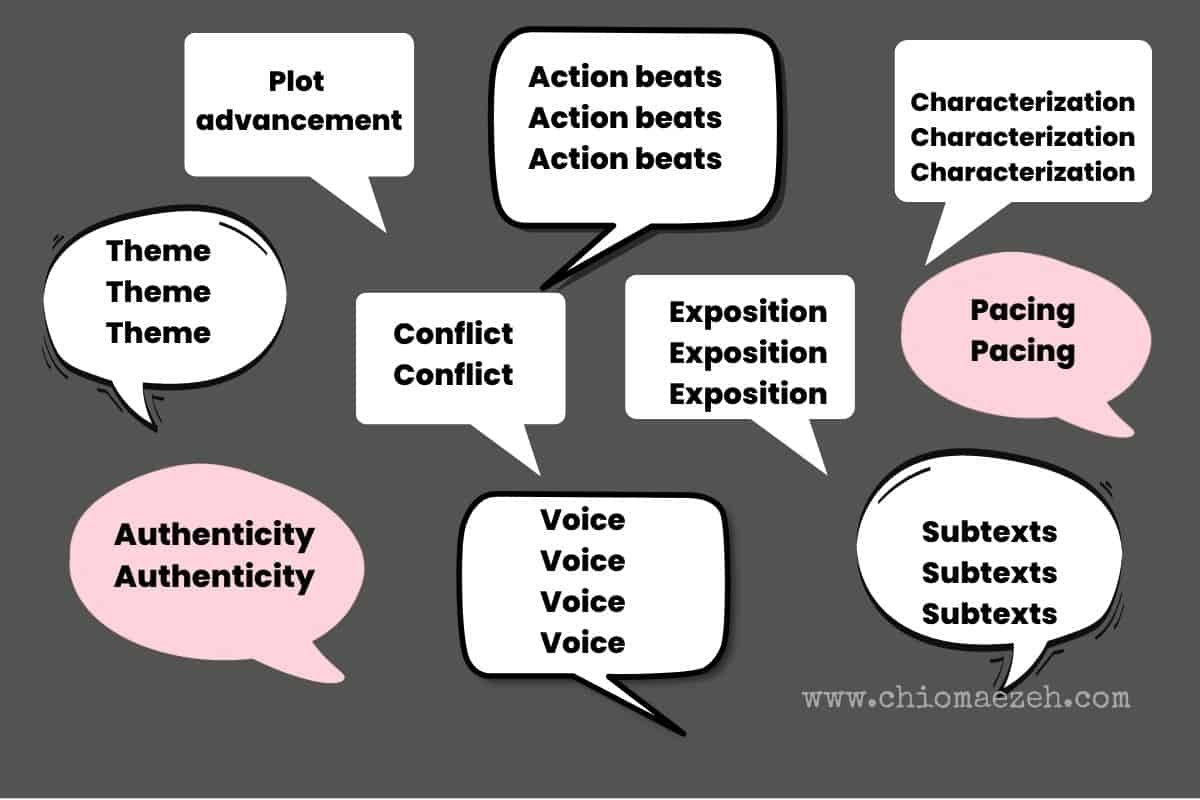6 Powerful Elements Of Dialogue Writing [Tags, Action Beats, Subtext & More]
Dialogue is a critical component of storytelling that allows writers to reveal their characters’ personalities, emotions, and motivations through conversations. Writing engaging and realistic dialogue can bring characters to life, immerse readers in the story, and propel the plot forward.
In this article, we will explore the key elements of dialogue writing and provide examples to help you understand and implement them in your work.
👉See our overview guide to writing dialogue for authors

Let’s Talk
Are you a writer aspiring to pen a masterpiece that never fails to captivate? Look no further. Reach out to us and uncover how we can help you to take your writing to unprecedented heights!

What Is Dialogue Writing?
Dialogue writing is the process of crafting conversations between two or more characters in a story, screenplay, play, or other narrative forms. It involves creating realistic and engaging exchanges that help to develop characters, advance the plot, reveal information, and evoke emotions.
Dialogue writing plays a crucial role in storytelling. It brings characters to life, provides insight into their personalities and motivations, and helps create a dynamic and immersive experience for the reader or audience.
How Does Dialogue Writing Fit Into The Overall Story Structure?
Dialogue writing fits into the overall story structure by serving several critical functions that contribute to the development and progression of the narrative. These functions include:
- Character Development: Helps to establish and deepen characters by revealing their personalities, backgrounds, values, and motivations.
- Plot Advancement: Moves the plot forward by introducing new information, creating conflicts, and resolving issues between characters.
- Conflict and Tension: Create or intensify conflict and tension between characters.
- Exposition: Dialogue can deliver information and backstory to the reader without resorting to lengthy descriptive passages.
- Pacing and Rhythm: Well-written dialogue can create a sense of urgency or slow down the narrative.
- Setting and Atmosphere: Dialogue can be used to convey the setting and atmosphere of the story, as characters may discuss their surroundings or react to specific events or situations.
- Theme: Dialogue can be used to explore and convey the story’s themes and underlying messages.
In summary, dialogue writing is an integral part of the overall story structure, as it contributes to character development, plot advancement, conflict, exposition, pacing, setting, and theme exploration.
Effective dialogue writing enhances the narrative and creates a rich, engaging experience for readers or audiences.
What Are The Elements Of Dialogue Writing?
1. Voice:
Each character should have a unique voice reflecting their personality, background, and emotions. Pay attention to vocabulary, sentence structure, and tone when crafting a character’s voice.
Example:
“Nothin’ much, just chillin’,” said the laid-back teenager.
“Indeed, I’ve been perusing the latest scientific journal,” remarked the erudite professor.
2. Subtext:
Subtext is the underlying meaning or emotion beneath the spoken words. Characters may not always express their true intentions, and their genuine feelings can be revealed through actions, reactions, or the context of the conversation.
Example:
“I’m fine,” she said, avoiding his gaze. Her voice wavered, betraying her true feelings.
3. Conflict:
Dialogue can generate conflict between characters. This often helps drive the plot forward. Additionally, it exposes the characters’ motivation.
Example:
“You never listen to me,” she shouted, her frustration boiling over.
“I’m not the one who’s always talking over people,” he snapped back.
To effectively employ dialogue in creating conflict, you must use action beats and appropriate dialogue tags. Dialogue is a great tool I used to establish conflict.
4. Exposition:
Dialogue can deliver essential information to the reader, but it should be done organically and avoid feeling forced or unnatural.
Example:
“Do you remember when we first met, at the company retreat in Aspen?” asked Sarah, reminiscing about their shared history.
In this example, there is exposition about the character’s history. This helps the reader to understand the context and the characters’ motivations.
5. Pacing:
Dialogue can influence the pace of a story. Brief, snappy exchanges can create tension or urgency, while longer, more reflective conversations can slow the pace and allow for in-depth character development.
Example:
“Go!” she urged. “Now!”
“Wait,” he replied, “we need a plan.”
Aside from monosyllabic words or brief exchanges, punctuations often affect the pace. While exclamation marks may be used to increase tension, ellipses can be employed to slow down the pace or kill off conversations
6. Authencity:
Dialogue should sound natural and believable, reflecting how people speak in real life. Real-life conversations often have pauses, interruptions, and tone shifts. And so should written dialogue be.
Example:
“I, um, I just wanted to say,” he stammered, “I think you’re, well, amazing.”
FAQs On Elements Of Dialogue Writing
What is dialogue writing?
Dialogue writing is the conversations between two or more characters in a story, screenplay, or other narrative forms. It helps to develop characters, advance the plot, reveal information, and create emotional depth in the story.
What are the key elements of dialogue writing?
- Authenticity: Create believable and natural conversations that reflect how people speak in real life, while also being mindful of the context, culture, and era of your story.
- Characterization: Use dialogue to reveal a character’s personality, background, and relationships with others. c.
- Conflict and tension: Dialogue can be used to build conflict and tension between characters, which helps to drive the story forward. d.
- Subtext: Subtext refers to the unspoken or underlying meaning behind the words. Skillful use of subtext adds depth and complexity to the dialogue. e.
- Pacing: Vary the length and rhythm of dialogue to maintain reader interest and create a natural flow in the conversation.
- Voice: Each character should have a distinct voice or speaking style, making it easy for readers to identify who is speaking.
How do I write realistic dialogue?
To write realistic dialogue, listen to how people speak in real life, and try to replicate the natural flow of conversation. Pay attention to different accents, dialects, speech patterns, and vocabulary. It’s essential to keep in mind the context, characters, and setting of your story when crafting dialogue.
What are some common dialogue writing mistakes to avoid?
Some common mistakes of dialogue writing include overusing dialogue tags, excessive exposition, unnatural speech, and monotonous pacing where all characters speak in the same rhythm or pattern.
How can I improve my dialogue writing skills?
To improve your dialogue writing skills, practice regularly, read books, screenplays, or plays with strong dialogue, and analyze how the authors create engaging and realistic conversations. Additionally, observing and participating in real-life conversations can help you gain insights into how people speak, their speech patterns, and the flow of conversation.
Final Notes On Elements Of Dialogue Writing
In conclusion, dialogue writing is a crucial aspect of storytelling that brings characters to life, advances the plot, and adds depth to a narrative. To write engaging and realistic dialogue, keep the following key points in this article in mind. When you do this, you’ll be able to create engaging, authentic, and impactful dialogues that enrich your narrative and captivate readers.




![What Are Action Beats in Writing? [Definition + Examples]](https://chiomaezeh.com/wp-content/uploads/2023/04/what-is-an-action-beat-768x512.jpg)
![What Is Introduction In A Story? [Explained]](https://chiomaezeh.com/wp-content/uploads/2023/02/introduction-in-a-story-1-768x512.jpg)
![How Does Dialogue Affect A Story? [Here’s how]](https://chiomaezeh.com/wp-content/uploads/2023/03/how-does-dialogue-affect-a-story-768x512.jpg)